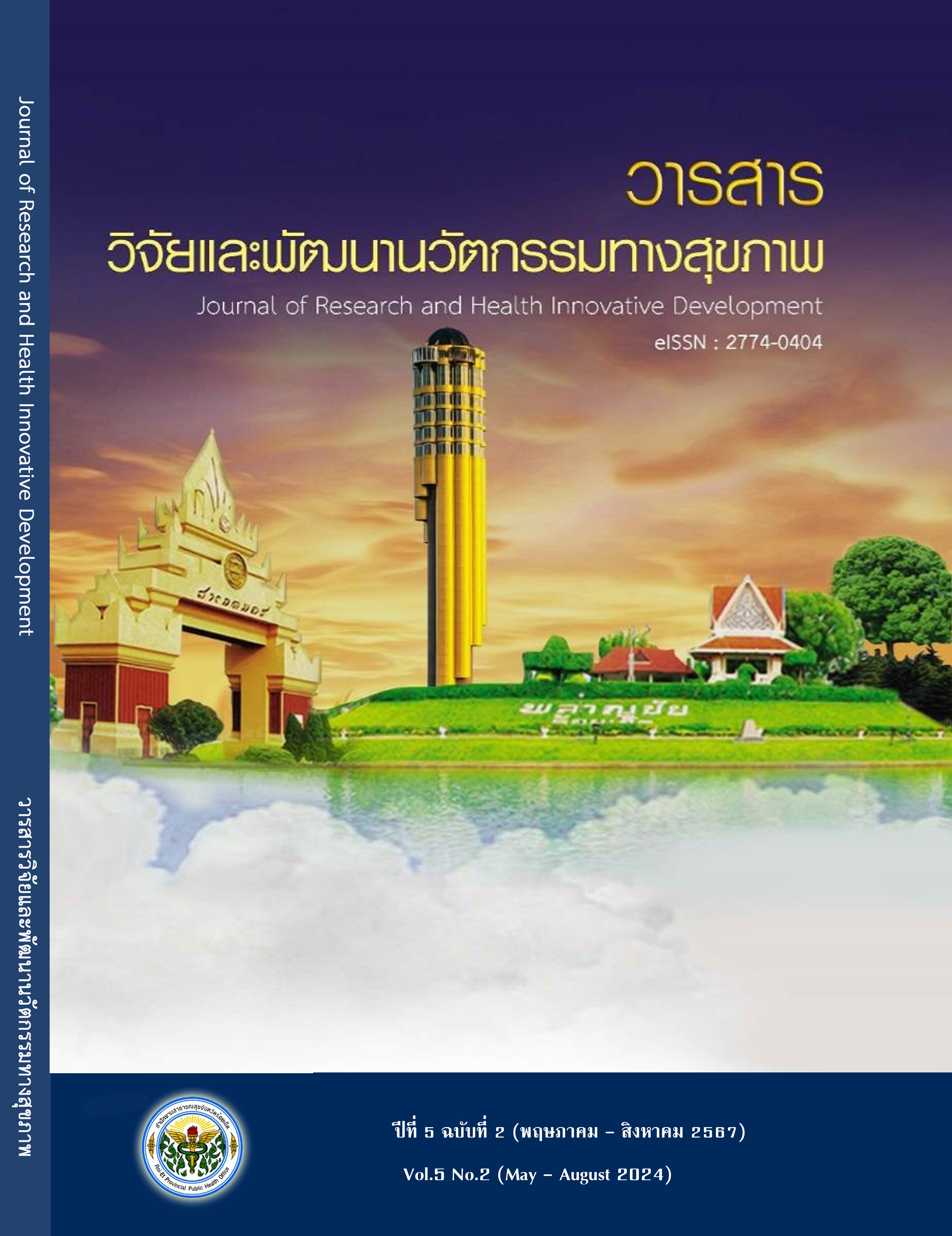Evaluation of the Aging Health Promotion Innovation in Elderly School in Roi Et Province
Keywords:
Aging health promotion innovation, Wellness Plan, Elderly schoolAbstract
Purpose ; To evaluation of the aging health promotion Innovation in elderly school by compared before and after of the health condition and behavior.
Study design : Participatory action Research.
Materials and Methods : The operation in the elderly persons in 6 elderly school in Roi Et province there are 184 persons. The study using the ageing health promotion innovation in elderly school is “no falling, no dementia, no depressed and eat delicious course” in llesson plan at the elderly school. At least a time per month and 3 hours by the time, and using the Wellness Plan for practice at home, the periods for using the ageing health promotion Innovation in elderly school is 6 months. The materials in the study is the interview form. The quantity data by Paired t-test and McNemar’s Chi-square statistic. The study is on March, 2022- January,2023. Mean age (minimum-maximum) of the subjects was 69.18 ± 6.40 years (60 - 87 years), mostly 134 females (72.8%).
Main findings : After using the aging health promotion innovation in elderly school. The weight, waist, the problem of falling, risk of falling, average of timing of TUGT, the risk of depressed (2Q+) are not significant different (p>.05. The average of diastolic blood pasture, the knee pain problem are significant decreased. The average of AMT score is significant increased (p=.021). The average of health behavior score is increased especially the teeth brush in 2 munities per day and sleeping for 7-8 hours per day behavior are significant (p=.038, .013)
Conclusion and recommendation : The goal of aging health promotion innovation in elderly school are health literacy in elderly persons. The health promotion to correct the health personal risk and community participation. To expand the results in another elderly school and the elderly persons out of elderly school.
References
กลุ่มอนามัยผู้สูงอายุ สำนักส่งเสริมสุขภาพ กรมอนามัย กระทรวงสาธารณสุข. รายงานการสำรวจสุขภาวะผู้สูงอายุไทย ปี 2556 ภายใต้แผนงานส่งเสริมสุขภาพผู้สูงอายุและผู้พิการ. กรุงเทพฯ: วัชรินทร์ พี.พี.; 2556.
กรมอนามัย กระทรวงสาธารณสุข. คู่มือแนวทางการขับเคลื่อนแผนปฏิบัติการ การส่งเสริมสุขภาพผู้สูงอายุ กรมอนามัย; 2562.
สำนักส่งเสริมสุขภาพ กรมอนามัย กระทรวงสาธารณสุข. รายงานการสำรวจสุขภาวะผู้สูงอายุไทย ปี2563. กรุงเทพฯ: วัชรินทร์ พี.พี.; 2563.
กรมกิจการผู้สูงอายุ กระทรวงการพัฒนาสังคมและความมั่นคงของมนุษย์. คู่มือโรงเรียนผู้สูงอายุ. กรุงเทพฯ: กองส่งเสริมศักยภาพผู้สูงอายุ; 2562.
ฐิติชญา ฉลาดล้น, สุทธีพร มูลศาสตร์, วรรณรัตน์ ลาวัง. การพัฒนารูปแบบกิจกรรมสร้างเสริมสุขภาพผู้สูงอายุในชมรมผู้สูงอายุคลังปัญญา อำเภอบ้านโป่ง จังหวัดราชบุรี. วารสารพยาบาลพยาบาลกระทรวงสาธารณสุข. 2560;27(2):154-67.
น้ำทิพย์ ยิ้มแย้ม, ยุวดี รอดจากภัย. ผลของโปรแกรมเสริมสร้างพลังอำนาจผู้ดูแลในการดูแลผู้สูงอายุกลุ่มเสี่ยงโรคความดันโลหิตสูง ตำบลแก่งดินสอ อำเภอนาดี จังหวัดปราจีณบุรี. สำนักงานป้องกันควบคุมโรคที่ 7 ขอนแก่น. 2560;24(2):45-58.
สำนักอนามัยผู้สูงอายุ กรมอนามัย. คู่มือมาตรฐานบริการส่งเสริมสุขภาพผู้สูงอายุในโรงพยาบาลชุมชนและโรงพยาบาลส่งเสริมสุขภาพตำบล. กรุงเทพฯ: สำนักบริการวิชาการ มหาวิทยาลัยศิลปากร; 2561.
สุวิมล แสงเรือง และคณะ. ผลของการใช้หลักสูตรไม่ล้ม ไม่ล้ม ไม่ซึมเศร้า กินข้าวอร่อย ร่วมกับแผนการดูแลสุขภาพรายบุคคล (Wellness Plan) แบบมีส่วนร่วมในผู้สูงอายุกลุ่มเสี่ยง 9 ด้าน. วารสารสุขภาพและสิ่งแวดล้อมศึกษา. 2566;8(4):233-43.
ปัทมา ผาติภัทรกุล, ผุสดี ก่อเจดีย์, พเยาว์ พงษ์ศักดิ์ชาติ, ศิริธร ยิ่งเรงเริง, ชุติมา บูรพา, ประภาส จักรพล. ประสิทธิผลโปรแกรมส่งเสริมสุขภาพต่อพฤติกรรมสุขภาพของผู้สูงอายุในชุมชน จังหวัดสระบุรี. วารสารวิจัยทางวิทยาศาสตร์สุขภาพ. 2561;12(ฉบับพิเศษ):52-60.
Downloads
Published
Versions
- 2024-05-07 (3)
- 2024-05-07 (2)
- 2024-05-07 (1)
How to Cite
Issue
Section
License

This work is licensed under a Creative Commons Attribution-NonCommercial-NoDerivatives 4.0 International License.
บทความที่ได้รับการตีพิมพ์เป็นลิขสิทธิ์ของ สำนักงานสาธารณสุขจังหวัดร้อยเอ็ด
บทความที่ลงตีพิมพ์ในวารสารวิจัย และพัฒนานวัตกรรมทางสุขภาพ สํานักงานสาธารณสุขจังหวัดร้อยเอ็ด ถือเป็น ผลงานวิชาการ งานวิจัย วิเคราะห์ ตลอดจนเป็นความเห็นส่วนตัวของผู้ประพันธ์ กองบรรณาธิการไม่จําเป็นต้องเห็น ด้วยเสมอไป และผู้ประพันธ์จะต้องรับผิดชอบต่อบทความของตนเอง


